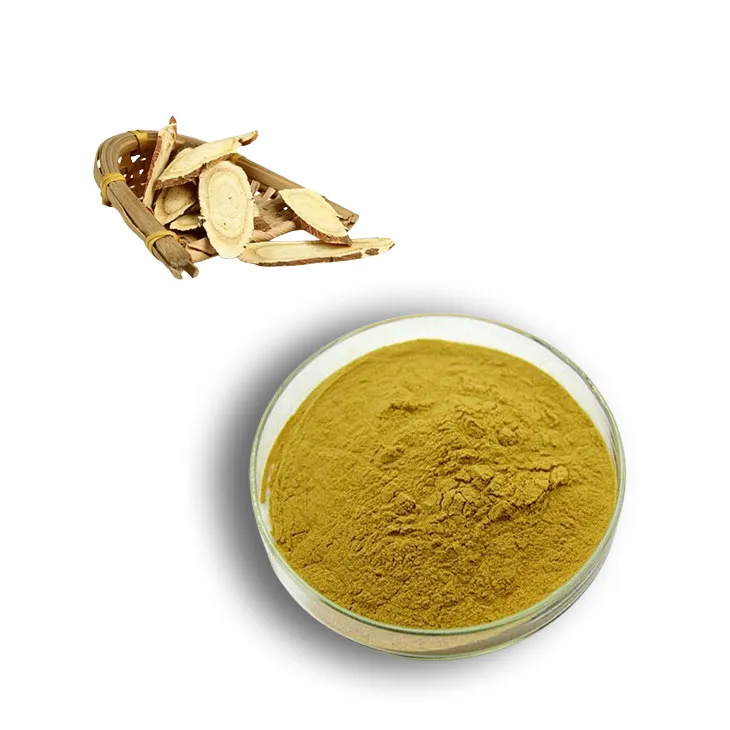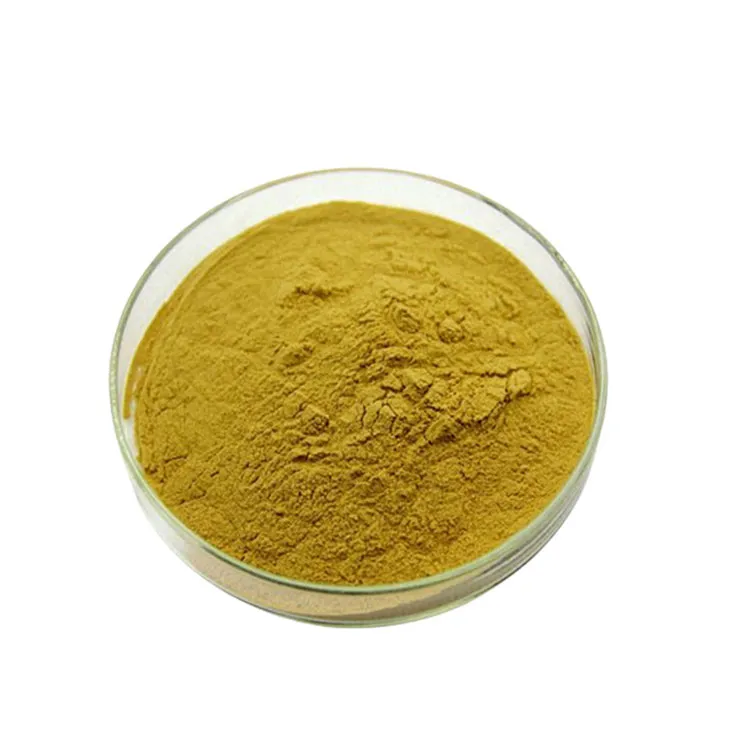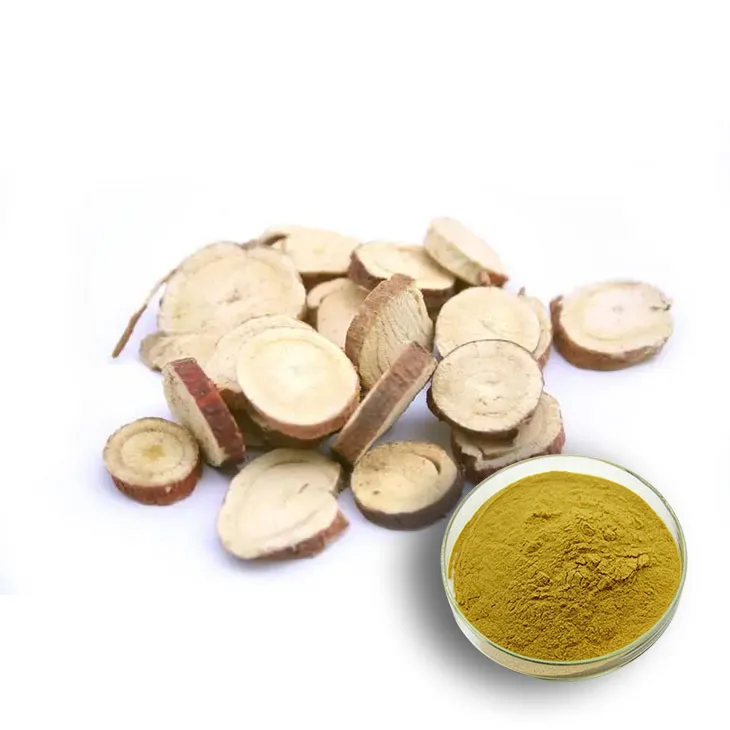- 0086-571-85302990
- sales@greenskybio.com
How to Extract Licorice Root Extract Powder from Plants.
2024-11-30

1. Introduction to Licorice
Licorice, scientifically known as Glycyrrhiza glabra, has been an important plant in various fields for centuries. Medicinally, it has been used in traditional medicine systems around the world. In Chinese medicine, for example, licorice is often used to soothe the throat, relieve coughs, and modulate the properties of other herbs in a formula. In Western medicine, licorice has also shown potential in treating certain inflammatory conditions.
In the food industry, licorice extract is used as a flavoring agent. The unique sweet and slightly anise - like flavor of licorice adds a distinct taste to candies, beverages, and some baked goods. It is also used in the cosmetic industry. Licorice root extract is believed to have skin - soothing properties, and it can be found in products such as creams, lotions, and serums aimed at reducing skin inflammation, hyperpigmentation, and promoting overall skin health.

2. Traditional Extraction Methods
2.1 Maceration
Maceration is one of the traditional methods of extracting licorice root. This process involves the following steps:
- First, the licorice roots are carefully collected and cleaned. Any dirt, debris, or damaged parts of the roots are removed.
- The clean roots are then chopped into small pieces. This increases the surface area of the roots, which is beneficial for the extraction process.
- The chopped licorice roots are placed in a suitable container, usually a glass or ceramic vessel. A solvent, typically ethanol or water, is added to the container. The ratio of the solvent to the licorice root pieces is important. For example, a common ratio could be 5:1 (solvent to root by volume).
- The container is then sealed and left to stand at room temperature for a period of time, usually several days to a few weeks. During this time, the active compounds in the licorice roots gradually dissolve into the solvent through diffusion.
- After the maceration period, the liquid is separated from the solid licorice root residue. This can be done through filtration using a filter paper or a fine - meshed sieve. The resulting liquid is the licorice root extract, which can then be further processed to obtain the powder form.
2.2 Decoction
Decoction is another traditional extraction method:
- The licorice roots are first prepared in a similar way as in maceration, i.e., cleaning and chopping into small pieces.
- The chopped roots are placed in a pot or a suitable cooking vessel. Water is added in an appropriate amount, usually enough to cover the roots completely.
- The pot is then heated, and the contents are brought to a boil. Once boiling, the heat is reduced, and the mixture is simmered for a certain period of time, typically 30 minutes to a few hours. This gentle simmering helps to extract the active components from the licorice roots into the water.
- After simmering, the liquid is strained to separate it from the solid roots. The resulting liquid can be concentrated further if needed. However, it should be noted that decoction may not be suitable for extracting heat - sensitive compounds in licorice roots as the high - temperature process may degrade some of these components.

3. Modern Extraction Techniques
3.1 Supercritical Fluid Extraction (SFE)
Supercritical fluid extraction is a more advanced and efficient method for extracting Licorice Root Extract Powder.
- The process uses a supercritical fluid, usually carbon dioxide (CO₂). Carbon dioxide is preferred because it is non - toxic, non - flammable, and has a relatively low critical temperature (31.1 °C) and pressure (73.8 bar). At supercritical conditions, carbon dioxide has properties of both a gas and a liquid, which makes it an excellent solvent for extracting a wide range of compounds.
- The licorice roots are first dried and ground into a fine powder. This increases the surface area available for extraction.
- The powdered licorice roots are placed in an extraction vessel. Supercritical carbon dioxide is then pumped into the vessel at the appropriate temperature and pressure conditions. The supercritical CO₂ penetrates the licorice root powder and selectively extracts the desired compounds, such as glycyrrhizic acid and other flavonoids.
- After extraction, the supercritical fluid containing the extracted compounds is passed through a separator. By changing the pressure and temperature conditions in the separator, the carbon dioxide can be easily separated from the extracted compounds, leaving behind a concentrated licorice root extract. This extract can be further processed into a powder form, for example, by freeze - drying or spray - drying.
3.2 Ultrasonic - Assisted Extraction
Ultrasonic - assisted extraction is also a modern and effective technique:
- The licorice roots are prepared by cleaning and cutting into suitable pieces or grinding into a powder.
- An extraction solvent, such as ethanol or water, is added to the licorice root material. The mixture is placed in an ultrasonic bath or an ultrasonic probe is inserted into the mixture.
- The ultrasonic waves create cavitation bubbles in the solvent. When these bubbles collapse, they generate intense local heating, pressure, and shear forces. These forces help to break the cell walls of the licorice roots more effectively, allowing the active compounds to be released into the solvent more rapidly compared to traditional extraction methods.
- After a certain period of ultrasonic treatment, which can range from a few minutes to an hour depending on the sample size and other factors, the extract is separated from the solid residue by filtration. The resulting liquid extract can then be further processed to obtain the Licorice Root Extract Powder.

4. Quality Control Measures
4.1 Identification of Active Compounds
One of the key aspects of quality control in Licorice Root Extract Powder production is the identification of active compounds. High - performance liquid chromatography (HPLC) is a commonly used technique for this purpose.
- HPLC can accurately separate and quantify the main active components in licorice root extract, such as glycyrrhizic acid. By comparing the chromatogram of the extract with that of a standard reference material, the purity and concentration of the active compounds can be determined.
- Another method for identifying active compounds is spectroscopy. For example, infrared spectroscopy (IR) can provide information about the functional groups present in the licorice root extract, which can be used to confirm the presence of certain compounds or to detect any impurities.
4.2 Purity and Contamination Checks
Ensuring the purity of the licorice root extract powder and checking for contaminants are essential quality control steps.
- Heavy metal analysis is carried out to detect the presence of harmful heavy metals such as lead, mercury, and cadmium. Excessive levels of these heavy metals can pose a risk to human health if the extract is used in food, medicine, or cosmetics. Atomic absorption spectroscopy (AAS) or inductively coupled plasma - mass spectrometry (ICP - MS) are often used for heavy metal analysis.
- Microbial contamination is also a concern. Tests for bacteria, fungi, and yeasts are performed to ensure that the extract meets the required microbiological standards. Plate count methods and polymerase chain reaction (PCR) - based techniques can be used to detect and quantify microbial contaminants.
- Residue analysis of pesticides and herbicides is necessary if the licorice roots are grown in agricultural settings where these chemicals may have been used. Gas chromatography - mass spectrometry (GC - MS) or liquid chromatography - tandem mass spectrometry (LC - MS/MS) can be employed to detect and quantify pesticide and herbicide residues.
4.3 Standardization of Extract
Standardization of the licorice root extract is crucial for ensuring consistent quality.
- The content of the main active compound, usually glycyrrhizic acid, is standardized. This means that the extract is adjusted to contain a specific amount of glycyrrhizic acid within a defined range. For example, in some pharmaceutical or dietary supplement products, the licorice root extract may be standardized to contain 5 - 10% glycyrrhizic acid.
- Standardization also involves ensuring that the physical and chemical properties of the extract, such as solubility, pH, and viscosity, are within the specified limits. This helps to ensure that the extract behaves consistently in different applications, whether it is in a medicine formulation, a food product, or a cosmetic.

5. Conclusion
Extracting licorice root extract powder from plants involves a combination of traditional and modern techniques. Each extraction method has its own advantages and limitations. Traditional methods like maceration and decoction are relatively simple and may be more suitable for small - scale or home - based extractions. However, modern techniques such as supercritical fluid extraction and ultrasonic - assisted extraction offer higher efficiency, better selectivity, and can often produce extracts with higher quality and purity.
Quality control measures play a vital role in ensuring the safety and effectiveness of licorice root extract powder. By accurately identifying active compounds, checking for purity and contaminants, and standardizing the extract, producers can meet the requirements of different industries, including medicine, food, and cosmetics. With the increasing demand for natural products, the proper extraction and quality control of licorice root extract powder will continue to be an important area of research and development.
FAQ:
What are the main applications of licorice root?
Licorice root has various applications. In traditional medicine, it is used for its potential anti - inflammatory, anti - viral, and expectorant properties. In the food industry, it is used as a flavoring agent in candies, beverages, and other products. It also has applications in cosmetics due to its soothing and antioxidant properties.
What are the traditional methods of extracting licorice root extract powder?
Traditional methods of extracting licorice root extract powder often involve maceration and decoction. Maceration is the process of soaking the licorice root in a solvent (usually water or alcohol) for a period of time to allow the active compounds to dissolve. Decoction is boiling the licorice root in water to extract the desired components.
What are the modern techniques for extracting licorice root extract powder?
Modern techniques for extracting licorice root extract powder include supercritical fluid extraction (SFE), which uses supercritical carbon dioxide as a solvent. This method has the advantages of being more efficient, producing a purer extract, and being more environmentally friendly. Another modern technique is microwave - assisted extraction (MAE), which uses microwave energy to accelerate the extraction process.
How is the quality of licorice root extract powder controlled?
Quality control of licorice root extract powder involves several aspects. Firstly, the raw materials need to be carefully selected and authenticated to ensure they are of high quality. During the extraction process, parameters such as temperature, pressure, and extraction time need to be closely monitored. After extraction, the extract powder is analyzed for its active ingredient content, purity, and absence of contaminants. Analytical methods such as high - performance liquid chromatography (HPLC) are often used for this purpose.
What are the safety considerations when extracting licorice root extract powder?
When extracting licorice root extract powder, safety considerations are important. If using solvents such as alcohol, proper handling and ventilation are required to prevent fire and inhalation hazards. Also, over - extraction or improper extraction methods may lead to the presence of harmful substances in the extract. Additionally, for those with certain health conditions, excessive consumption of licorice - containing products may have adverse effects, so this should be taken into account during production.
Related literature
- Extraction and Characterization of Licorice Root Extract"
- "The Role of Licorice Root in Traditional and Modern Medicine"
- "Modern Extraction Technologies for Herbal Extracts: A Case of Licorice Root"
- ▶ Hesperidin
- ▶ citrus bioflavonoids
- ▶ plant extract
- ▶ lycopene
- ▶ Diosmin
- ▶ Grape seed extract
- ▶ Sea buckthorn Juice Powder
- ▶ Beetroot powder
- ▶ Hops Extract
- ▶ Artichoke Extract
- ▶ Reishi mushroom extract
- ▶ Astaxanthin
- ▶ Green Tea Extract
- ▶ Curcumin Extract
- ▶ Horse Chestnut Extract
- ▶ Other Problems
- ▶ Boswellia Serrata Extract
- ▶ Resveratrol Extract
- ▶ Marigold Extract
- ▶ Grape Leaf Extract
- ▶ blog3
- ▶ blog4
-
The Most Highly - Praised Lavender Extract.
2024-11-30
-
Organic Goldenseal Extract Powder Suppliers.
2024-11-30
-
Standard - process pine bark extract powder.
2024-11-30
-
Nature's Bounty Almond Powder
2024-11-30
-
Organic Taurine Powder Suppliers.
2024-11-30
-
Bulk purchase of black pepper extract.
2024-11-30
-
Okra Extract
2024-11-30
-
Feverfew Extract
2024-11-30
-
Honeysuckle Pollen
2024-11-30
-
Lavender Extract
2024-11-30
-
Diosmin
2024-11-30
-
Pueraria Lobata Extract
2024-11-30
-
Curcuma Longa Extract/Turmeric extract
2024-11-30
-
Yellow Pine Extract
2024-11-30
-
Ginseng Root Extract
2024-11-30
-
Maitake Mushroom Extract
2024-11-30





















